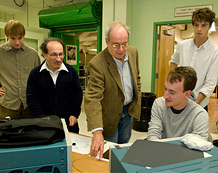University-Argonne-Fermi collaboration
lights up
When you look at the stars in the sky, what you see is not there anymore. The stars are so far away that by the time their light reaches the Earth they have already moved considerably. In fact, some of the stars might have burned up by the time you see them.
There's also a time lag in what you see all around. "Look at a building across the street... it's no longer what you see," says Henry Frisch, PhD, Professor in Physics at the University of Chicago.
Of course, the time it takes for light to travel from objects to our eyes in daily life is insignificant. Nevertheless, such time lags are extremely important to scientists as they measure the velocity of sub-atomic particles, search for particles that make up dark matter, or advance the quality of medical imaging.
That's why researchers at the University of Chicago, Argonne National Laboratory, Enrico Fermi Institute, Fermi National Accelerator Laboratory and elsewhere are working together to improve devices that detect and measure light.
"If you know precisely where light arrives, when it arrives and how long it took to get there, you can get better time-of-flight measurements at particle accelerators, identify new kinds of matter, create sharper PET scan images in order to detect tumors earlier, and more," says Frisch.
Currently, large-area light detectors used by particle physicists can measure the time-of-arrival of a photon of light down to an accuracy of 10 picoseconds. (A picosecond is one trillionth of a second.) Meanwhile, a 2-inch-by-2-inch light detector—which can measure the time-of-arrival of a photon of light to an accuracy of 10 picoseconds—costs about $11,000, much more per unit area than the large-area detectors presently in use, and consequently too expensive to be useful in the big collider experiments.
Frisch and his colleagues aim to combine the best of these two systems by building a large window-sized detector that would cost much less― yet measure time-of-arrival down to one picosecond. Bigger, cheaper, more accurate. An $8 million American Recovery and Reinvestment Act grant from the U.S. Department of Energy's Office of High Energy Physics gives them three years to produce a working prototype.
"Initially driven by the desire to do particle identification at colliders, we are now trying to make a detector that would have multiple applications," says Erik Ramberg, PhD, a Fermilab particle physicist. Potential applications are vast in high-energy physics, medical imaging, national defense, commercial products, solar panels and other green technologies, and basic science.
Just one application could justify the entire expense of the program, according to Karen Byrum, PhD, a high energy physicist at Argonne. The government is building the Deep Underground Science and Engineering Lab at Homestake, S.D., to address the underground needs of all major scientific fields that the National Science Foundation funds: particle and nuclear physics, geology, hydrology, geo-engineering, biology, and biochemistry. Rooms 8,000 feet below ground will house detectors to study neutrinos and search for signs of dark matter, among other things.
"Currently, to build these detectors the government would have to spend more than $200 million on phototubes, the production of which has moved overseas," Byrum said. "With our grant, the government intends to spark the production of detectors that would replace the phototubes at a big savings. At the same time, the grant could rekindle American knowledge and expertise in this field."
"Already," says Frisch, "the proliferation of detectors, sensors and monitors has revolutionized our world." "From lasers that are bounced off the moon to automobile headlights that respond to ambient light, many of these devices depend on the measurement of light. Our research will create a platform of products and ideas that could be useful in a wide variety of ways."
For this to happen the scientists have to succeed on two levels: research and development, and the marketplace.
"Even if we build a great device, it’ll be useless unless we can scale up," Frisch says. "Therefore, we’re working with potential American business partners to look at business models, product lines and price points. You can’t wait until the end of the invention process to do that."
While risk is high for this project, having many diverse partners and technological paths diversifies the risk and increases the chance of success, scientifically and commercially, he adds. The team includes four national labs, five Argonne divisions, three universities and three U.S. companies.
"We'll make mistakes along the way, but if we didn't, that would mean we're not moving fast enough," Frisch says. "I think we’ll deliver, especially since Argonne is such a great collaborator, with expertise in many areas, from materials science to micro-electronics to nanotechnology."
by Greg Borzo

Michael Baumer, Jean-Francois Genat, Henry Frisch, Eric Oberla, and Herve Grabas gather in the Enrico Fermi Institute's "Eshop". (Photo by Lloyd DeGrane)










